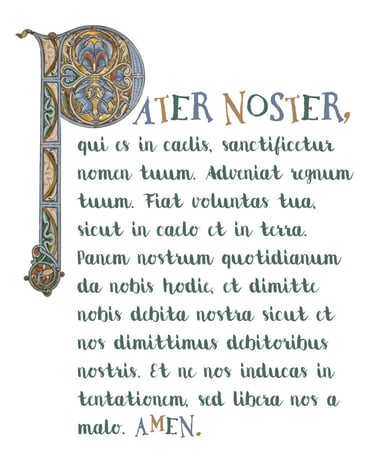2 - The prayers at the bottom of the altar:
The priest stands at the altar as a sign of humility and regret for his faults. The Mass begins with a sign of the cross:
it is the not bloody but real renewal of the sacrifice of the Cross to the glory of the Holy Trinity.
The antiphon Introïbo (verse of Psalm 42)
Explanation and unfolding of the traditional Mass of Saint Pius V according to the 1962 missal.
3 - Confiteor (the confession of sins) :
Clasping his hands, the priest bowed and said:
Confíteor Deo omnipoténti, Beatae Mariæ semper Virgini, Beato Michaeli Archangelo, Beato Ioanni Baptístæ, sanctis Apostolis Petro et Paulo, Omnibus Sanctis, et vobis, fratres: quia peccavi nimis cogitatióne, verbo et opere : mea culpa, mea culpa, mea maxima culpa. Ideo precor beátam Mariam semper Virginem, beátum Michaélem Archángelum, beátum Ioannem Baptístam, sanctos Apostolos Petrum et Paulum, omnes sanctos, et vos, fratres, orare pro me ad Dominum, Deum nostrum.
I confess to Almighty God, to the Blessed Mary always Virgin, to Blessed Michael Archangel, to Blessed John the Baptist, to the Holy Apostles Peter & Paul, to all the Saints, and to you, brothers, that I have sinned a great deal in thought, in word and in action.
It’s my fault, it’s my fault, it’s my great fault. Therefore I beseech the Blessed Mary always Virgin, Blessed Michael Archangel, Blessed John the Baptist, the Holy Apostles Peter and Paul, all the saints, and you, brothers, to pray for me the Lord our God.
6 - The Kyrie.
In this litany we call the mercy of the Holy Trinity: the Father (Kyrie in Greek), the Son (Christe) and the Holy Spirit (Kyrie).
Kyrie, eleison. (have mercy)
Kyrie, eleison.
Kyrie, eleison.
Christe, eleison.
Christe, eleison.
Christe, eleison.
Kyrie, eleison.
Kyrie, eleison.
Kyrie, eleison
4 - Prayer.
The priest goes up to the altar, bows down and says the prayer in honor of the saints whose relics are contained in the altar and all the saints.
Orámus te, Dómine, per mérita Sanctórum tuórum, quorum relíquiæ hic sunt, et ómnium Sanctórum: ut indulgére dignéris ómnia peccáta mea. Amen. (We ask you, Lord, by the merits of your Saints, whose relics we have here, and of all the saints, to deign to forgive me all my sins. Amen.)
The priest lowers the altar and incenses it as a mark of adoration and love for Christ whom the altar represents.
7 - Gloria In Excelsis deo : (sung)
Then the Priest kisses the Altar in the middle, and says turned towards the faithful
Prêtre : Dóminus vobíscum (The Lord be with you)
the church attendants : Et cum spíritu tuo (And with your Spirit) Prêtre : Oremus (let us pray)
9 - The Epistle.
The Epistle is a reading from the letters of the Apostles.
8 - The collection.
The Priest "gathers" the prayers and aspirations of the faithful. This is the first of the three great prayers proper to each Mass. The Priest pronounces them arms apart and raised to show that the prayer he pronounces for the people is directed towards God.
14 - The Offertory:
Offertory means "offering to God". The quest or offerings have this meaning. This preparation for sacrifice means the very offering of the church - that of heaven, purgatory and earth - and puts us in the feelings that must be ours before such a great mystery.
The prayers date back to the Middle Ages. They express what is being done on the altar and what will become of the bread and wine.
Offering of bread.
Water blessing
Offering of the Chalice.
Prayer of humility.
Invocation to the Holy Spirit.
Incensing.
Hand washing
Prayer to the Holy Trinity.
Prayer of the faithful.
Secret prayer.
Preface to the Holy Trinity.
17 - Consecration of the Body of the Lord
This is the centre of the same. Christ, the high priest, represents to his Father the only sacrifice of Calvary. The victim is the same as the priest. Only, differs the way of offering: bloody on the Cross, sacramental at Mass.Jesus acts through the priest who becomes In Persona Christi.
Qui prídie quam paterétur, accépit panem in sanctas ac venerábiles manus suas, et elevatis oculis in caelum ad te Deum Patrem suum omnipotentem, tibi gratias agens, bene dixit, fregit,de ditque discipulis suis, dicen : Accipite, et manducate ex hoc omne ; hox est enim corpus meum.
On the eve of the day when he suffered, he took bread from his holy and venerable hands and, with his eyes raised to heaven towards you, God his Almighty Father, giving you thanks, blessing, breaking and giving to his disciples, saying: Take and eat all of this: for this is my body.
18 - The consecration of the Most Precious Blood.
Simili modo, postquam cenatum est, accipiens et hunc praeclarum clicem in sanctas ac venerabiles manus suas, item tibi gratias agens, bene dixit, deditque discipulis suis, dicens :
Accipite et bibite ex eo omnes.
Hic est enim calix sanguinis mei, novi et aeterni testamenti : mysterium fidei : qui pro vobis et pro multis effundetur in remissionem peccatorum.
Likewise, after the meal, taking also this most glorious chalice in his holy and venerable hands, giving you thanks again, he blessed it and gave it to his disciples, saying: Take, and drink in all: for this is the chalice of my blood, that of the new and eternal covenant: mystery of faith: which will be poured out for you and for many in remission of sins.
19 - Prayer for the deceased :
Meménto étiam, Dómine, famulórum famularúmque tuárum N. et N., qui nos præcessérunt cum signo fídei, et dórmiunt in somno pacis. Ipsis, Dómine, et ómnibus in Christo quiescéntibus, locum refrigérii, lucis et pacis, ut indúlgeas , deprecámur. Per eúndem Christum Dóminum nostrum. Amen.
(Remember also, Lord, of Your servants and Your servants... N. and N. who went before us, marked with the seal of faith, and who sleep in the sleep of peace. To these, Lord, and to all who rest in Christ, grant, we beg You, the Dwelling of happiness, light and peace. Through Christ our Lord. So be it).
20 - Communion of Saints:
Nobis quoque peccatóribus fámulis tuis, de multitúdine miseratiónum tuárum sperántibus, partem áliquam et societátem donáre dignéris, cum tuis sanctis Apóstolis et Martýribus : cum Ioánne, Stéphano, Matthía, Bárnaba, Ignátio, Alexándro, Marcellíno, Petro, Felicitáte, Perpétua, Agatha, Lúcia, Agnéte, Cæcília, Anastásia, et ómnibus Sanctis tuis : intra quorum nos consórtium, non æstimátor mériti, sed véniæ, quǽsumus, largítor admítte. Per Christum, Dóminum nostrum.
(To us also sinners, Your servants, who put our trust in Your infinite Mercy, deign to grant a place in the Community of your Holy Apostles and Martyrs, with John, Stephen, Matthias, Barnabas, Ignatius, Alexander, Marcellin, Peter, Felicity, Perpetual, Agatha, Lucia, Agnes, Cecilia, Anastasia, and with all your Saints. To admit us to their company, do not weigh the value of our actions, but give us your Forgiveness widely. Through Christ our Lord. So be it).
21 - Conclusion of the Canon.
Per quem hæc ómnia, Dómine, semper bona creas, sanctificas, vivíficas, benedícis et præstas nobis.
Per ipsum, et cum ipso, et in ipso, est tibi Deo Patri omnipotenti, in unitáte Spíritus Sancti, omnis honor, et glória.
(Excelsa voce) : Per omnia saecula saecolorum. Amen. (through him, Lord, you do not cease to create all these goods and you sanctify them, you live them and you bless them to give them to us.Through Him, with Him, and in Him, to you God the Almighty Father, in the unity of the Holy Spirit, all honor and glory.(Aloud): For ever and ever. Amen. )
26 - The communion of the faithful.
The Eucharist is received on the knees and on the tongue:
The consecrated host has become the true Body and Blood of Christ while the priest is “in persona Christi”. It must therefore be handled with the greatest respect. Only the priest who consecrated it can give it with the greatest precaution. The altar server places a small tray under the chin of the communicant so that no cash falls. If this is the case, it can be recovered in this way. The communicant who will receive the Body and Blood of Christ must be in an attitude of deep devotion and deep respect. So he gets down on his knees.
Corpus Dómini nostri Jesu Christi custódiat ánimam tuam in vitam ætérnam. Amen.
The Body of Our Lord Jesus Christ keeps your soul for eternal life. So be it.
27 - The blessing :
Prêtre : Benedícat vos omnípotens Deus, Pater, et Fílius, et Spíritus Sanctus. (May Almighty God, Father & Son & Holy Spirit bless you.)
The church attendants: Amen. (Thus be it.)

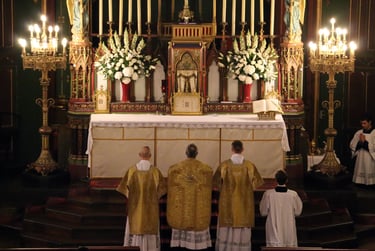


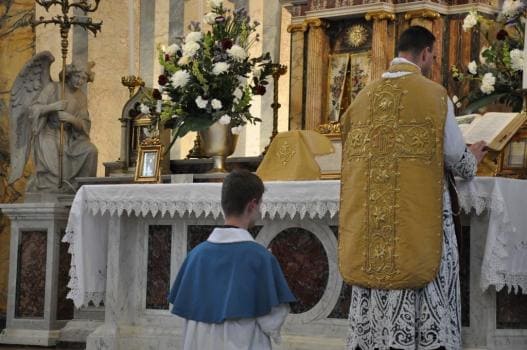

Mass of the catechumens (first part of the mass)
Mass of the faithful
(second part of the Mass)
Canon of the Mass
(third part of the Mass)

Beautiful video of the consecrations with the song Anima Christi in the background.

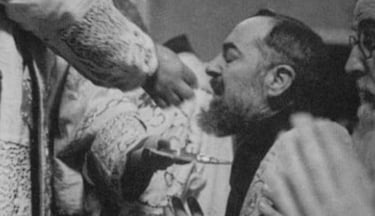
Padre PIO receiving Communion.
The traditional Mass particularly highlights the real renewal of the bloodless expiatory and propitiatory sacrifice of Our Lord Jesus Christ on the Cross.
She is imbued with great devotion, deep respect and much contemplation.
The Holy Mass of Saint Pius V is mainly in Latin, except for the priest's sermon which is in the vernacular.
Latin was the main language at the beginning of Christianity. It has become the language of the Church. As such, Latin has always been sacred. It is a “dead” language. It therefore has the advantage of no longer evolving. Thus, a very old text retains all its meaning even today. A vernacular language constantly evolving, an old text and its meaning would no longer have the same meaning. Finally, the Holy Mass remains essentially the same regardless of the country of celebration, except for the sermon and a few polyphonic songs. A believer is therefore not destabilized while traveling.
The Holy Mass alternates between readings, prayers, Gregorian chants and polyphonies in Latin or vernacular language.
It elevates the soul with its beauty and transcendence.
The progress of the Mass that you will read below is not exhaustive. However, it will give you a first glimpse.
Only experimentation will allow you to truly understand it.
The readings will give you precise teaching.

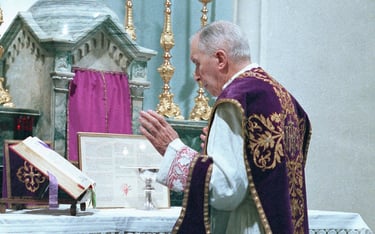

5 - The Introit:
The entrance Gregorian chant (introit sets the tone for the Mass that begins because it is specific to each Mass.

example of introit
11. Prayers before the Gospel.
The priest returns to the middle of the altar, bows down and whispers the two prayers to prepare him to proclaim the gospel :
Munda cor meum, ac labia mea, omnípotens Deus, qui labia Isaíæ Prophétæ cálculo mundásti igníto : ita me tua grata miseratióne dignáre mundáre, ut sanctum Evangélium tuum digne váleam nuntiáre. Per Christum, Dóminum nostrum. Amen.
(Purifiez mon cœur et mes lèvres, Dieu tout-puissant, qui avez purifié les lèvres du prophète Isaïe avec un charbon ardent ; daignez par votre miséricordieuse bonté me purifier, pour que je puisse proclamer dignement votre saint Evangile. Par le Christ notre Seigneur. Amen.)
10 - The gradual and the Alleluia:
These are two Gregorian chants specific to each Mass.

12 - The Gospel and the Homily:
The priest reads the gospel of the day before presenting his homily.
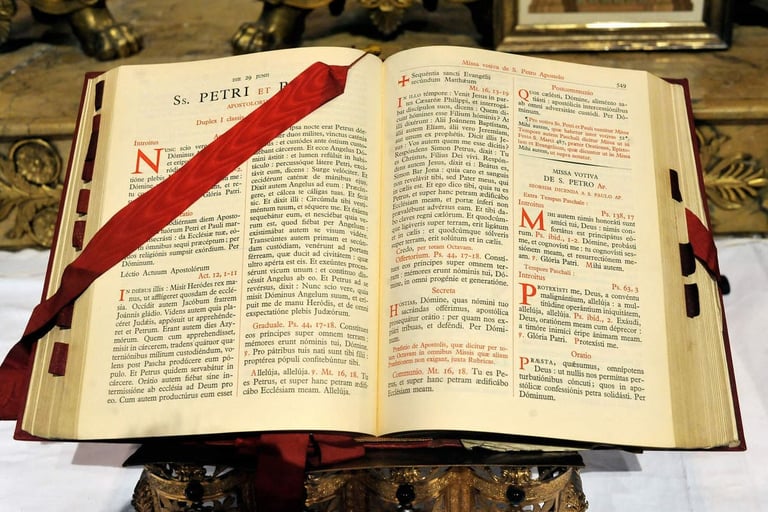

13 - The Creed:
On Sundays it is sung.



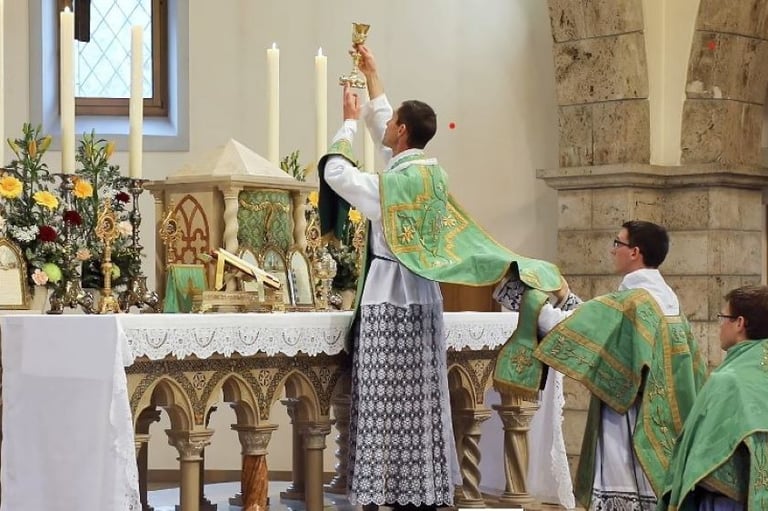


15 - Sanctus :
The sanctus is a Gregorian chant in Latin.
1 - Sprinkling of holy water:
Sprinkling is done every Sunday. The priest begins the antiphon "Asparagus me" taken by the church attendants. He blessed the altar, himself, the clergy and the faithful.
Aspérges me, Dómine, hyssópo, et mundábor : lavábis me, et super nivem dealbábor. Miserére mei, Deus, secúndum magnam misericórdiam tuam. Gloria Patri, et Filio, et Spiritui Sancto, sicut erat in principio, et nunc et semper, et in saecula saeculorum. Amen
Sprinkle me, Lord, with hyssop and I will be pure; wash me, and I will become whiter than snow. Have mercy on me, my God, in your great Mercy
Glory to the Father and to the Son and to the Holy Spirit, as he was in the Beginning, now and always, in the centuries of the centuries. So be it

28 - Salve Regina

24 - Agnus dei
25 - Presentation of the Body of the Lord to the faithful before communion.
Prêtre : Ecce Agnus Dei, ecce qui tollit peccáta mundi. (Behold the Lamb of God, behold the one who takes away the sins of the world.)
The church attendants : Domine, non sum dignus ut intres sub tectum meum, sed tantum dic verbo & sanábitur ánima mea. (Lord, I am not worthy of you coming under my roof, but just say one word and my soul will be healed.)
22 - Pater Noster
